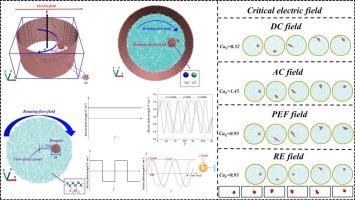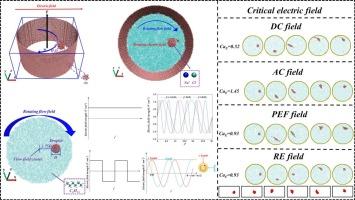Microscopic stabilization mechanism of droplet in the coupling of electric and rotating flow fields
IF 4.3
2区 工程技术
Q2 ENGINEERING, CHEMICAL
引用次数: 0
Abstract
Electrohydrodynamic manipulation of oil–water interfaces is a promising route for intensified separation and emulsion control, yet a molecular-level picture of how coupled electric and rotating flow fields (RF) dictate droplet stability is still lacking. In this paper, molecular dynamic (MD) simulations are performed to elucidate the droplet polarization, deformation, breakup and stability under direct current (DC) field, alternating current (AC) field, pulsed electric field (PEF) and rotating electric field (RE), respectively, acting simultaneously with a RF field. The results show that (i) the nature of the electric field dominates the breakup threshold: DC fields stretch droplets continuously and give the lowest critical electrocapillary number (CaE), whereas the periodic reversal of AC fields favor rapid retraction and afford the highest stability; overall stability follows the order of AC field > RE field > PEF field > DC field. (ii) Coupling electric and centrifugal forces significantly amplifies droplet deformation; an appropriate angular velocity, however, suppresses breakup and enlarges the droplet stability. (iii) Dipole moment build-up and hydrogen-bond depletion are identified as molecular signatures of impending instability: DC fields induce the fastest loss of hydrogen bonding, while AC and RE fields mitigate electrostatic overstretching and preserve interfacial structure. (iv) Optimizing electric-field frequency (5–6.7 GHz for PEF) and introducing Span-80 and SiO2 synergistic effects enhance stability, efficiently suppressing breakup even under strong fields. These findings clarify how electric and hydrodynamic forces, together with interfacial additives, synergistically manipulate droplet stability, and provide theoretical guidance for the design of high-efficiency electro-centrifugal separators.


电旋流场耦合下液滴的微观稳定机理
油水界面的电流体动力学操作是加强分离和乳状液控制的一种很有前途的途径,但关于耦合电和旋转流场(RF)如何决定液滴稳定性的分子水平图像仍然缺乏。本文通过分子动力学(MD)模拟研究了液滴在直流(DC)场、交流(AC)场、脉冲电场(PEF)和旋转电场(RE)与射频场同时作用下的极化、变形、破裂和稳定性。结果表明:(1)电场的性质决定了液滴的破裂阈值:直流电场连续拉伸液滴并给出最低的临界电毛细数(CaE),而交流电场的周期性逆转有利于快速缩回液滴并提供最高的稳定性;总体稳定性依次为交流场 >; RE场 >; PEF场 >; 直流场。(ii)电离心力耦合作用显著放大液滴变形;适当的角速度抑制了液滴的破裂,增大了液滴的稳定性。(iii)偶极矩积累和氢键耗尽被确定为即将发生的不稳定性的分子特征:直流场诱导氢键损失最快,而交流和RE场减轻静电过度拉伸并保持界面结构。(iv)优化电场频率(PEF为5-6.7 GHz),引入Span-80和SiO2协同效应,增强了稳定性,即使在强电场下也能有效抑制破裂。这些发现阐明了电动力和水动力以及界面添加剂如何协同操纵液滴稳定性,并为高效电离心分离器的设计提供了理论指导。
本文章由计算机程序翻译,如有差异,请以英文原文为准。
求助全文
约1分钟内获得全文
求助全文
来源期刊

Chemical Engineering Science
工程技术-工程:化工
CiteScore
7.50
自引率
8.50%
发文量
1025
审稿时长
50 days
期刊介绍:
Chemical engineering enables the transformation of natural resources and energy into useful products for society. It draws on and applies natural sciences, mathematics and economics, and has developed fundamental engineering science that underpins the discipline.
Chemical Engineering Science (CES) has been publishing papers on the fundamentals of chemical engineering since 1951. CES is the platform where the most significant advances in the discipline have ever since been published. Chemical Engineering Science has accompanied and sustained chemical engineering through its development into the vibrant and broad scientific discipline it is today.
 求助内容:
求助内容: 应助结果提醒方式:
应助结果提醒方式:


